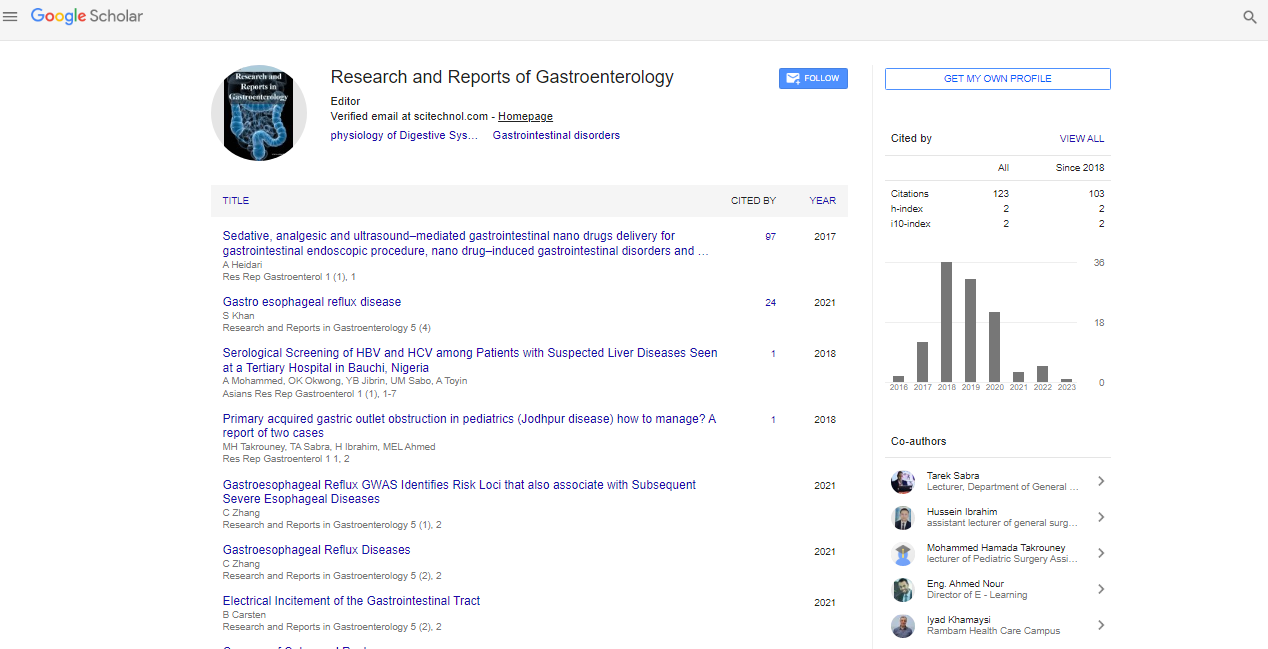Commentary, Res Rep Gastroenterol Vol: 7 Issue: 2
Emerging Trends in Endoscopic Imaging for the Diagnosis of Gastrointestinal Lesions
Sarah Fernandez*
1Department of Gastroenterology and Hepatology, NYU Grossman School of Medicine, New York, USA
*Corresponding Author: Sarah Fernandez,
Department of Gastroenterology and
Hepatology, NYU Grossman School of Medicine, New York, USA
E-mail: fernandezrsarah@gmail.com
Received date: 15 May, 2023, Manuscript No RRG-23-106612;
Editor assigned date: 17 May, 2023, PreQC No RRG-23-106612 (PQ);
Reviewed date: 01 June, 2023, QC No RRG-23-106612;
Revised date: 08 June, 2023, Manuscript No RRG-23-106612 (R);
Published date: 16 June, 2023, DOI: 10.4172/Rrg.1000139
Citation: Fernandez S (2023) Emerging Trends in Endoscopic Imaging for the Diagnosis of Gastrointestinal Lesions. Res Rep Gastroenterol 2023, 7:2.
Abstract
Description
Endoscopic imaging plays an important role in the diagnosis and management of Gastrointestinal (GI) lesions. With advancements in technology, there has been a significant evolution in endoscopic imaging techniques, enabling improved visualization and characterization of GI lesions. The endoscopic imaging that are revolutionizing the diagnosis of GI lesions, leading to more accurate and efficient detection and characterization.
High-definition endoscopy
High-Definition (HD) endoscopy represents a significant advancement in endoscopic imaging. HD endoscopes provide enhanced resolution and clarity, allowing for better visualization of subtle lesions and fine details of the GI mucosa. The improved image quality aids in the early detection and precise delineation of lesions, enabling targeted biopsies and reducing the likelihood of missed lesions.
Narrow-band imaging
Narrow-Band Imaging (NBI) is a technique that enhances the visual contrast of blood vessels and surface patterns on the GI mucosa. By narrowing the bandwidth of light, NBI highlights mucosal structures and capillary networks, providing detailed information about the vasculature. This technique aids in the characterization of GI lesions, particularly in the detection of early-stage neoplastic lesions, such as superficial gastric and colorectal cancers.
Chromoendoscopy
Chromoendoscopy involves the application of dyes or stains to the GI mucosa to improve lesion visualization and characterization. Indigo carmine and acetic acid are commonly used stains in chromoendoscopy. Indigo carmine enhances the contrast between the lesion and the surrounding mucosa, aiding in lesion detection and delineation. Acetic acid causes changes in the mucosal surface and can help identify subtle abnormalities, such as dysplastic changes in Barrett's esophagus.
Virtual chromoendoscopy
Virtual chromoendoscopy techniques, such as Blue Light Imaging (BLI) and Flexible Spectral Imaging Color Enhancement (FICE), simulate the effect of chromoendoscopy without the need for dye application. BLI enhances the visualization of superficial mucosal structures, providing detailed information about the mucosal surface and vascular patterns. FICE enhances the color contrast of the GI mucosa, aiding in the detection and characterization of lesions. Virtual chromoendoscopy techniques offer the advantage of real-time imaging without the additional step of dye application.
Confocal laser endomicroscopy
Confocal Laser Endomicroscopy (CLE) is a real-time imaging technique that enables microscopic visualization of the GI mucosa at a cellular level. By using a laser to produce optical sections, CLE provides real-time histological information during endoscopy. CLE aids in the detection and characterization of lesions, including the differentiation of neoplastic and non-neoplastic mucosa. It also facilitates targeted biopsies and can guide endoscopic interventions.
Endocytoscopy
Endocytoscopy allows in vivo microscopic imaging of the GI mucosa at a cellular level. It utilizes high magnification to visualize cellular structures, providing real-time histopathological information. Endocytoscopy aids in the differentiation of neoplastic and nonneoplastic lesions, guiding targeted biopsies and reducing the need for unnecessary sampling.
Artificial intelligence
The integration of Artificial Intelligence (AI) and machine learning algorithms in endoscopic imaging is an emerging trend that holds immense potential. AI can aid in real-time lesion detection, characterization, and classification, improving the accuracy and efficiency of endoscopic diagnosis. Deep learning algorithms can analyze large datasets, identifying subtle features and patterns that may be missed by the human eye. AI-assisted endoscopic imaging has the potential to enhance lesion detection rates, reduce missed diagnoses, and improve patient outcomes.
Conclusion
Emerging trends in endoscopic imaging have revolutionized the diagnosis of gastrointestinal lesions. High-definition endoscopy, narrow-band imaging, chromoendoscopy, virtual chromoendoscopy, confocal laser endomicroscopy, endocytoscopy, and artificial intelligence are all contributing to improved lesion detection, characterization, and targeted biopsy. These advancements enhance the precision and efficiency of endoscopic diagnosis, leading to early detection, better treatment planning, and improved patient outcomes. Continued research and technological advancements in endoscopic imaging will further refine these techniques and expand their applications in the diagnosis and management of gastrointestinal lesions.
 Spanish
Spanish  Chinese
Chinese  Russian
Russian  German
German  French
French  Japanese
Japanese  Portuguese
Portuguese  Hindi
Hindi 